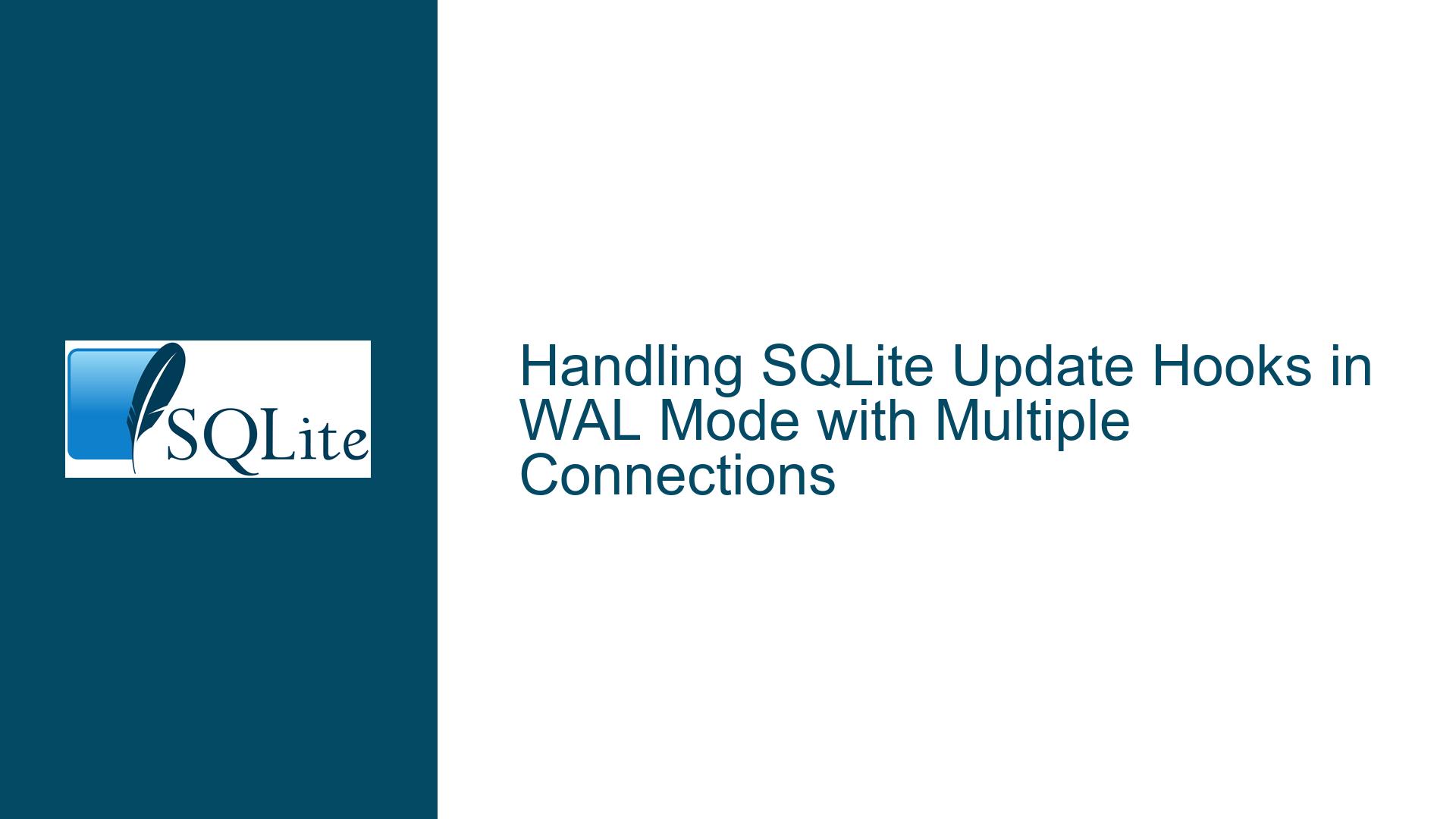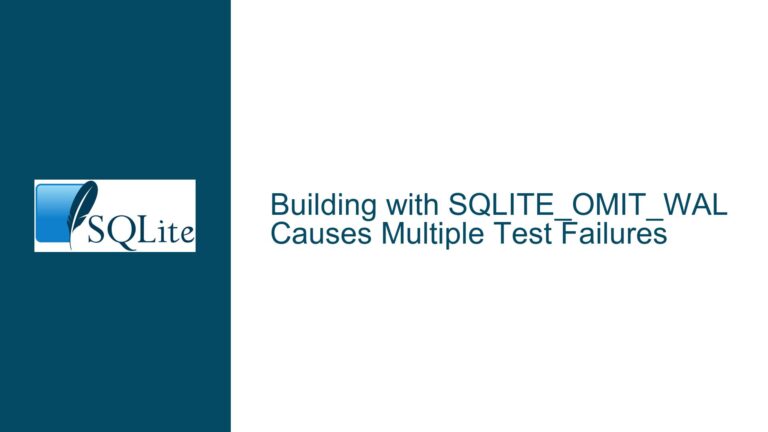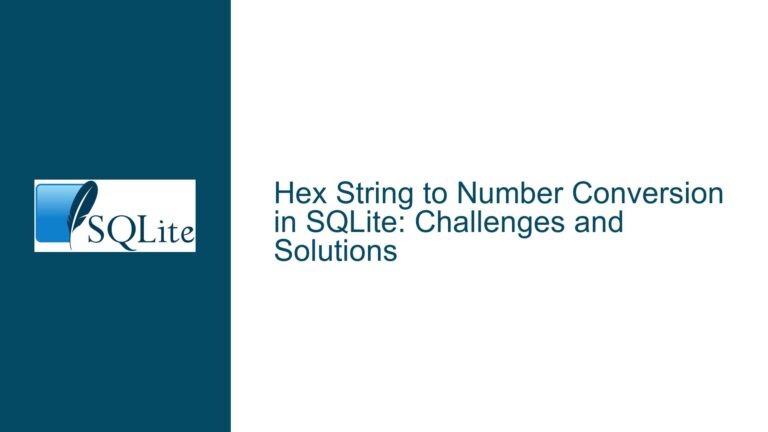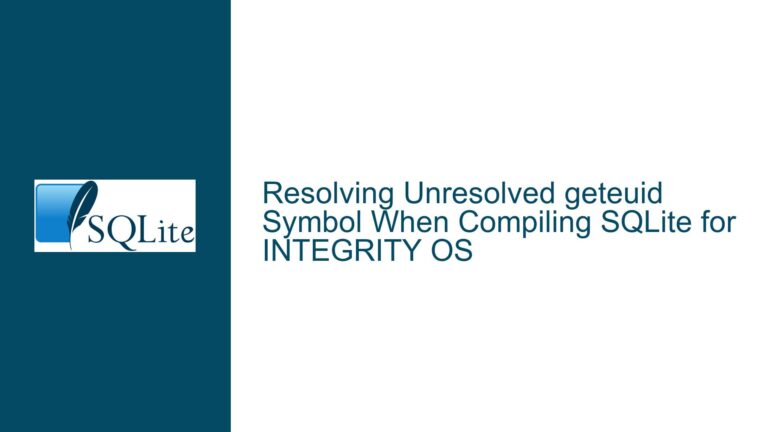Handling SQLite Update Hooks in WAL Mode with Multiple Connections
Understanding the Update Hook Mechanism in SQLite with WAL Mode Enabled
When working with SQLite in an Android application, enabling Write-Ahead Logging (WAL) mode can significantly improve performance, especially in scenarios with concurrent read and write operations. However, this performance boost comes with its own set of challenges, particularly when dealing with database hooks such as sqlite3_update_hook. The update hook is a powerful feature that allows developers to monitor changes to the database, but its behavior can become unpredictable when multiple database connections are involved, as is often the case with WAL mode.
In a typical single-connection scenario, the update hook is straightforward to implement. You register the hook on a specific database connection, and it triggers whenever a change is made through that connection. However, when WAL mode is enabled, Android’s SQLite implementation may create a connection pool, leading to multiple database connections being opened simultaneously. This can cause the update hook to fail or behave inconsistently, as it is tied to a specific connection rather than the database as a whole.
The core issue here is that the update hook is designed to operate on a per-connection basis. When multiple connections are involved, changes made through one connection may not trigger the hook registered on another connection. This can lead to missed updates or inconsistent behavior, depending on how the connections are managed and used within the application.
To address this issue, it is essential to understand the underlying mechanisms of both the update hook and WAL mode. The update hook is registered using the sqlite3_update_hook function, which takes three arguments: the database connection, the callback function, and a user-defined pointer. The callback function is invoked whenever an INSERT, UPDATE, or DELETE operation is performed on the database through the specified connection. The user-defined pointer can be used to pass additional context or data to the callback function.
In the context of WAL mode, the database connection pool managed by Android can lead to multiple connections being used interchangeably. This means that the update hook registered on one connection may not capture changes made through another connection. To solve this problem, we need to ensure that the update hook is registered on all active connections or find a way to centralize the hook logic so that it can capture changes regardless of which connection is used.
Potential Causes of Update Hook Failure in WAL Mode
The failure of the update hook in WAL mode can be attributed to several factors, each of which needs to be carefully considered when diagnosing and resolving the issue. One of the primary causes is the inherent design of the update hook itself, which is tied to a specific database connection rather than the database as a whole. This design choice makes sense in a single-connection context but becomes problematic when multiple connections are involved.
Another potential cause is the way Android manages database connections in WAL mode. When WAL mode is enabled, Android may create a connection pool to handle concurrent read and write operations more efficiently. This connection pool can lead to multiple connections being opened and closed dynamically, making it difficult to ensure that the update hook is consistently registered on all active connections.
Additionally, the update hook may fail if the connection on which it is registered is closed or if the hook is not properly propagated to new connections created by the connection pool. This can result in the hook being active on some connections but not others, leading to inconsistent behavior.
The use of JNI (Java Native Interface) in the Android application adds another layer of complexity. The update hook is registered in native code, and any issues with the JNI implementation, such as incorrect handling of the JavaVM pointer or improper reference management, can also contribute to the failure of the update hook.
Finally, the design of the callback function itself may play a role in the issue. If the callback function relies on specific context or data that is not properly passed through the user-defined pointer, it may fail to execute correctly when triggered by changes made through different connections.
Comprehensive Troubleshooting and Solutions for Update Hook Issues in WAL Mode
To resolve the issue of the update hook failing in WAL mode, a multi-faceted approach is required. This approach should address the underlying causes of the problem and provide robust solutions that ensure the update hook works consistently across all database connections.
1. Registering the Update Hook on All Active Connections
One of the most straightforward solutions is to ensure that the update hook is registered on all active database connections. This can be achieved by maintaining a list of all open connections and iterating through them to register the hook whenever a new connection is created. In the context of an Android application, this would involve modifying the native code to track connections and register the hook accordingly.
For example, you could create a global list of SQLiteConnection objects and add each new connection to this list when it is opened. Then, whenever the update hook needs to be registered, you can iterate through the list and register the hook on each connection. This ensures that the hook is active on all connections, regardless of which one is used to make changes to the database.
2. Centralizing the Update Hook Logic
Another approach is to centralize the update hook logic so that it can capture changes regardless of which connection is used. This can be achieved by using a combination of the user-defined pointer and a shared context object that is accessible to all connections. The user-defined pointer can be used to pass a reference to this shared context object, allowing the callback function to access the necessary data and perform the required actions.
In the context of the provided code, this would involve modifying the nativeUpdateHook function to pass a reference to a shared context object through the user-defined pointer. The callback function can then use this reference to access the shared context and perform the necessary actions when triggered.
3. Properly Managing JNI References and Context
Given that the update hook is registered in native code using JNI, it is essential to ensure that all JNI references are properly managed and that the necessary context is passed to the callback function. This includes ensuring that the JavaVM pointer is correctly handled and that any global references to Java objects are properly created and deleted to avoid memory leaks.
In the provided code, the JavaVM *javaVM; and env->GetJavaVM(&javaVM); lines appear to be unused and can potentially be removed unless they are required by the ALOGW macro. However, if the callback function needs to interact with Java objects, it is crucial to ensure that the necessary JNI references are properly managed and that the callback function has access to the required context.
4. Handling Connection Pool Dynamics
Finally, it is important to account for the dynamic nature of the connection pool in WAL mode. This means that the update hook should be registered not only on existing connections but also on any new connections that are created during the application’s runtime. This can be achieved by hooking into the connection creation process and registering the update hook whenever a new connection is opened.
In an Android application, this would involve modifying the native code to intercept the creation of new SQLiteConnection objects and register the update hook on each new connection. This ensures that the hook is active on all connections, regardless of when they are created.
5. Testing and Validation
Once the above solutions have been implemented, it is crucial to thoroughly test the application to ensure that the update hook works consistently across all connections. This includes testing with multiple concurrent read and write operations, as well as testing with different connection pool configurations to ensure that the hook is properly registered and triggered in all scenarios.
In conclusion, the issue of the update hook failing in WAL mode can be resolved by ensuring that the hook is registered on all active connections, centralizing the hook logic, properly managing JNI references and context, and accounting for the dynamic nature of the connection pool. By following these steps, you can ensure that the update hook works consistently and reliably, even in a multi-connection environment.






